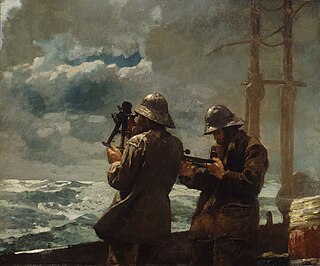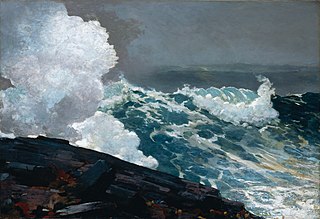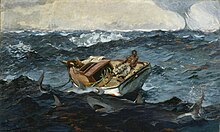
Édouard Manet was a French modernist painter. He was one of the first 19th-century artists to paint modern life, as well as a pivotal figure in the transition from Realism to Impressionism.

En plein air, or plein-air painting, is the act of painting outdoors.

George Inness was a prominent American landscape painter.

Jean Désiré Gustave Courbet was a French painter who led the Realism movement in 19th-century French painting. Committed to painting only what he could see, he rejected academic convention and the Romanticism of the previous generation of visual artists. His independence set an example that was important to later artists, such as the Impressionists and the Cubists. Courbet occupies an important place in 19th-century French painting as an innovator and as an artist willing to make bold social statements through his work.

Winslow Homer was an American landscape painter and illustrator, best known for his marine subjects. He is considered one of the foremost painters of 19th-century America and a preeminent figure in American art in general.

Eugène Louis Boudin was one of the first French landscape painters to paint outdoors. Boudin was a marine painter, and expert in the rendering of all that goes upon the sea and along its shores. His pastels, summary and economic, garnered the splendid eulogy of Baudelaire; and Corot called him the "King of the skies".

The Phillips Collection is an art museum founded by Duncan Phillips and Marjorie Acker Phillips in 1921 as the Phillips Memorial Gallery located in the Dupont Circle neighborhood of Washington, D.C. Phillips was the grandson of James H. Laughlin, a banker and co-founder of the Jones and Laughlin Steel Company.

Frank Weston Benson, frequently referred to as Frank W. Benson, was an American artist from Salem, Massachusetts known for his Realistic portraits, American Impressionist paintings, watercolors and etchings. He began his career painting portraits of distinguished families and murals for the Library of Congress. Some of his best known paintings depict his daughters outdoors at Benson's summer home, Wooster Farm, on the island of North Haven, Maine. He also produced numerous oil, wash and watercolor paintings and etchings of wildfowl and landscapes.

The Gulf Stream is an 1899 oil painting by Winslow Homer. It shows a man in a small dismasted rudderless fishing boat struggling against the storm-tossed waves and perils of the sea, presumably near the Gulf Stream, and was the artist's statement on a theme that had interested him for more than a decade. During the time he explored this theme, Homer, a New Englander, boated often near Florida, Cuba, and the Caribbean.

Eight Bells is an 1886 oil painting by the American artist Winslow Homer. It depicts two sailors determining their ship's latitude. It is one of Homer's best-known paintings and the last of his major paintings of the 1880s that dramatically chronicle man's relationship to the ocean.

Martín Malharro (1865–1911) was an Argentine painter who introduced Impressionism in the country in the early 20th century.

Right and Left is a 1909 oil on canvas painting by the American artist Winslow Homer. It depicts a pair of common goldeneye ducks at the moment they are hit by a hunter's shotgun blast as they attempt to take flight. Completed less than two years before his death, it was Homer's last great painting, and has been the subject of a variety of interpretations regarding its origin, composition and meaning. As with his other late masterworks, it represents a return to the sporting and hunting subjects of Homer's earlier years, and was to be his final engagement with the theme. Its design recalls that of Japanese art, and the composition resembles that of a colored engraving by John James Audubon.

The Fox Hunt is an 1893 oil on canvas painting by Winslow Homer. It depicts a fox running in deep snow, menaced by hungry crows. His largest single work, it has been described as "Homer's greatest Darwinian painting, arguably his greatest painting of any kind."

The Boat Builders is an oil painting on panel executed in 1873 by American landscape painter Winslow Homer. It is held in the collection of the Indianapolis Museum of Art (IMA), in Indianapolis, Indiana, United States.

Woman with a Parasol – Madame Monet and Her Son, sometimes known as The Stroll is an oil-on-canvas painting by Claude Monet from 1875. The Impressionist work depicts his wife Camille Monet and their son Jean Monet in the period from 1871 to 1877 while they were living in Argenteuil, capturing a moment on a stroll on a windy summer's day.

The Fog Warning is one of several paintings on marine subjects by the late-19th-century American painter Winslow Homer (1836–1910). Together with The Herring Net and Breezing Up, painted the same year and also depicting the hard lives of fishermen in Maine, it is considered among his best works on such topics.

Northeaster is one of several paintings on marine subjects by the late-19th-century American painter Winslow Homer. Like The Fog Warning and Breezing Up, he created it during his time in Maine. It is on display in the Metropolitan Museum of Art in New York. Viewers are presented a struggle of elements between the sea and the rocky shore. Winslow Homer excelled in painting landscape paintings that depicted seascapes and mountain scenery.

Ground Swell is a 1939 painting by American artist Edward Hopper which depicts five people on a heeling catboat in a light swell, looking at an ominous buoy. It was in the collection of the Corcoran Gallery of Art from 1943 until it was purchased by the National Gallery of Art in Washington, D.C. in 2014.

Grace Hoops is a genre painting by the American artist Winslow Homer. It depicts two young women outdoors playing the game of graces. Scenes of childhood innocence constituted one of Homer's recurring subjects throughout the 1870s. The work is now in the collection of the McMullen Museum of Art at Boston College, having been donated as part of the Carolyn A. and Peter S. Lynch collection.

Interior, after Dinner is an oil-on-canvas painting by French artist Claude Monet (1840–1926) created during the winter of 1868–1869, a productive time for the painter. He spent the winter in Étretat with his girlfriend Camille Doncieux and their newborn son.





















